Gross Anatomy
Feeding Time
Following Up
Conclusion
Frequently Asked Questions
Errata and Clarifications
Appendix: More Magazines
More articles
Discuss this article at

Following Up
If you've been keeping track, you'll notice I've cleverly avoided addressing the entire reason I was sent the magazines in the first place: to determine which one, if any, was contributing to the slide burrs. One can only play around with feed ramps so long, though, and at last I had no excuse but to take a look at the followers.
Followers are probably the least glamorous part of any gun, and in the 1911 they look pretty cheap. Function triumphs over form in this regard; follower angle helps determine where on the gun's frame ramp the bullet makes contact, and the lower leg of the follower catches and lifts the slide lock after the last round is ejected. Even the dimple on the follower serves an important purpose.
In this case, my goal here was to see if any of the followers was engaging the slide early or with unusual amounts of force. It's an easy situation to ascertain, albeit difficult to photograph. I started with the Colt hybrid mag because it shows how the original design is supposed to work.

Proper follower/slidelock engagement.
A couple things to notice in the photo above: The bump on the lower leg of the follower helps engage the slide lock lug, but in order to do so the lower leg's vertical component must be bent at 90 degrees to the follower proper. Here's what happens if the bend is shallower:
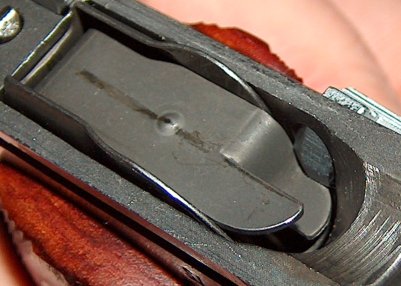
Note the difference between this Metalform follower's lower leg and the Colt above.
My Metalform magazine's lower leg is bent at less than 90 degrees, so the slide lock lug makes contact partly on the bottom foot of the follower, and partly on what should be its vertical surface. As a result, the follower gets dinged at the point of contact.
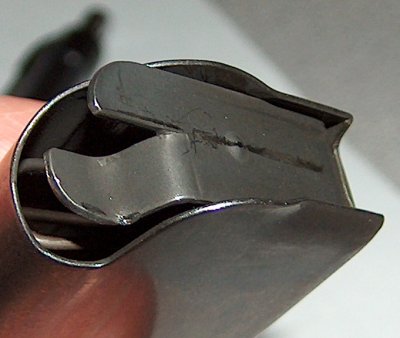
Burrs: Nature's way of indicating poor construction.
Another unfortunate side effect of the shallow leg bend is the possibility of the follower's leg slipping over the slide lock lug, preventing the slide from locking back after the last round and making it very difficult to remove the magazine. I don't even need to mention that this is a potentially bad thing, so I won't.
The Metalform mag with the rounded follower seemed to do a little better at catching the slide lock, but it was hard to get a photo of it.
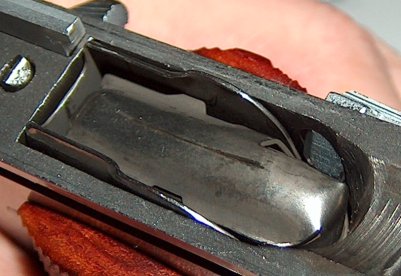
A different Metalform follower.
The flat Colt follower showed great engagement, which is probably why they're built as they are. By having no leg at the front of the follower, you're guaranteed to get clean support for the slide lock lug with little chance of the follower slipping over.
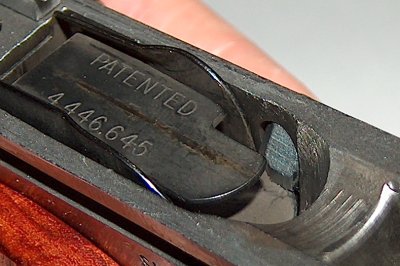
Flat Colt follower has clean engagement, but enough support?
Unfortunately for this particular magazine, there's a catch, or rather the lack thereof. Either the magazine springs or the follower design prevent it from holding the slidelock up with any force. It's very easy to depress the slide release with one's thumb even when the slide is locked back on the empty magazine.
There's not much to say about the Wilson magazine's follower. It engages the slide lock lug firmly enough that I would worry about eventual wear on the plastic from the lug.
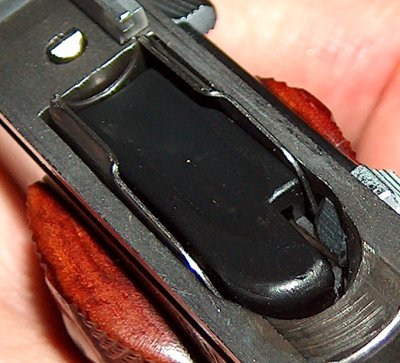
Wilson follower.
I've saved the best for last: the Para-Ordnance magazine.
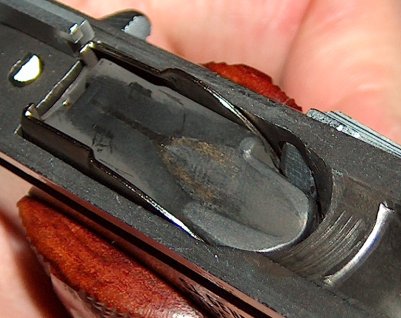
Tight call between Para follower and lug.
First, look at how high in the magwell the magazine sits. There is barely any slide clearance over the magazine's feed lips. When I tried the Para magazine in another 1911, it sat so high it prevented the slide from going forward and the the bottom of the magazine was pulled hard against the opening to the magwell. It feels almost like the magazine lock cutout was made too low.
As a result of sitting so high, the magazine's follower engages the slide lock lug with extreme prejudice, as evidenced by wear on the plastic where it meets the lug. It's impossible to depress the slide release by hand when it is supported by this mag's follower. The real kicker comes when cycling the last round out of the chamber over the empty magazine: As the slide brings the locking recess over the slide lock, there's a noticeable hitch as the lock is slammed into the recess by the follower, then forced down again by the continued rearward motion of the slide. This is present in all the magazines to some extent, but especially pronounced with the Para-Ordnance mag. In and of itself, positive follower engagement is not an issue; in fact, it's a good thing; if the slidelock is not all the way up, it can peen the back end of the slidelock notch. However, the follower is not supposed to be nailed in place. The front of the slide lock is angled for a reason: to shove the slide lock out of the way as the slide goes back should the slide lock happen to be bumped up prematurely, or in the case of the last round, when the slide lock is supported by the follower and the slide is in recoil. In these situations, the follower needs to give slightly. Browning's original follower and magazine spring specifications provide this amount of give; the Para-Ordnance magazine does not. The fact that the Para mag's plastic follower shows an indentation where it is contacted by the slidelock lug shows that it's being supported with more force than is require to deform high-impact plastic, which is likely enough force to turn the slidelock itself into an impact chisel.
I think we've found our culprit.
After posting the above conclusion, I was contacted by George Wedge, Manager of Quality at Para-Ordnance, who felt I was being unfair to his company's magazines. According to Mr. Wedge, their magazines are manufactured in such a fashion as to guarantee consistency from magazine to magazine. Provided that Para-Ordnance is able to achieve such a feat and all their magazines are exactly the same as the one I examined, it would actually go a long way toward explaining why their service department considers severe peening of the slidelock notch normal wear. It would also go a long way toward explaining the prevalent online myth of the Para-Ordnance "soft slide steel." Most people who use Paras in competition pooh-pooh the assertion that Para-Ordnance's slides are made of inferior steel. My current working theory is that competition usage of Paras is usually done with aftermarket magazines that do not engage the slidelock lug so violently, whereas the people from whom the "soft steel" myth originates use mostly OEM Para mags like as the one reviewed in this writeup. Mr. Wedge also opined that the slide peening was probably an issue with the gun itself and had nothing to do with the magazines, although that explanation does nothing to explain why the Para-Ordnance repair department considered the slide peening normal.
email: hidi.projects at gmail.com